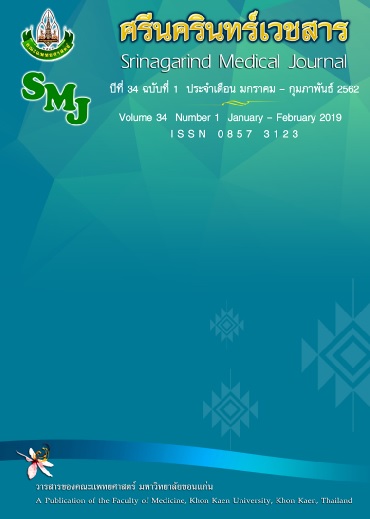ผลการสำรองเลือดของคลังเลือดกลาง เพื่อใช้ในโรงพยาบาลศรีนครินทร์และศูนย์หัวใจสิริกิติ์ภาคตะวันออกเฉียงเหนือ ในระยะเวลา 5 ปี (2556-2560)
คำสำคัญ:
ปริมาณเลือดสำรอง; ปริมาณเลือดคงคลังบทคัดย่อ
หลักการและวัตถุประสงค์: การจัดหาเลือดสำหรับผู้ป่วยที่เข้ารับการรักษาในโรงพยาบาล มีความสำคัญ ต้องมีเลือดสำรองพอเพียง สามารถเตรียมให้ผู้ป่วยได้ทันท่วงที การศึกษาครั้งนี้มีวัตถุประสงค์เพื่อประเมินผลการสำรองเลือดของคลังเลือดกลาง ตั้งแต่ปีพ.ศ. 2556-2560
วิธีการศึกษา: ทำการรวบรวมข้อมูลย้อนหลัง ปริมาณเลือดสำรองที่ควรมีในปีพ.ศ. 2556-2560 โดยรวบรวมข้อมูลสัปดาห์ละสองครั้ง ประกอบด้วยข้อมูลเลือดคงคลังและเลือดคงคลังที่มีอายุคงเหลือ 14 วันก่อนหมดอายุ
ผลการศึกษา การสำรองเลือดสำหรับใช้งานในแต่ละปีถูกกำหนดไว้ล่วงหน้า ผลการสำรองเลือดสำหรับใช้ เพียงพอ 7 วัน พบว่าในปีพ.ศ. 2558 มีปริมาณการสำรองในคลังเลือดกลางต่ำกว่าเกณฑ์มากที่สุด จำนวน 31 ข้อมูล (ร้อยละ 30.4) ขณะที่พบเพียง 3 ข้อมูล (ร้อยละ 2.86) ในปีพ.ศ. 2560 เมื่อพิจารณาผลการสำรองเลือดสำหรับใช้เพียงพอ 3 วัน พบเฉพาะปีพ.ศ. 2557 มีเลือดต่ำกว่าเกณฑ์จำนวน 5 ข้อมูล (ร้อยละ 5.38) สำหรับข้อมูลเลือดคงคลังของปริมาณเลือดสำรองที่มีอายุคงเหลือ 14 วัน ในปีพ.ศ. 2560 พบโดยเฉลี่ยที่ร้อยละ 16.5 (ร้อยละ 0.9-25.8) โดยพบเลือดหมู่ AB คงค้างในคลังมากที่สุด
สรุป: การสำรองเลือดของคลังเลือด สามารถทำได้ตามเกณฑ์กำหนด มีเฉพาะช่วงเวลาของการปรับเปลี่ยนการปิดภาคเรียนของนักศึกษาในปี พ.ศ. 2557 เท่านั้น ที่ทำให้เลือดสำรองต่ำกว่าเกณฑ์ อย่างไรก็ตามในปี พ.ศ. 2560 มีเลือดคงคลังที่มีอายุมากค้างอยู่ในคลังเลือด ดังนั้นในอนาคตการบริหารจัดการเลือด เพื่อให้ผู้ป่วยมีโอกาสใช้เลือดที่ใหม่ๆ จึงเป็นสิ่งท้าทาย
เอกสารอ้างอิง
2. อมรรัตน์ ร่มพฤกษ์, จินตนา พัวไพโรจน์. การสำรองเลือดสำหรับปี 2553 เพื่อใช้ในโรงพยาบาลศรีนครินทร์และศูนย์หัวใจสิริกิติ์ภาคตะวันออกเฉียงเหนือ. วารสารเทคนิคการแพทย์และกายภาพบำบัด 2553; 22: 139-48.
3. Almac E, Ince C. The impact of storage on red cell function in blood transfusion. Best Pract Res Clin Anaesthesiol 2007; 21: 195-208.
4. Tinmouth ADF, Chin-Yee I, Hebert PC. Clinical consequences of red cell storage in the critically ill. Transfusion 2006; 46: 2014-27.
5. Vamvakas EC, Carven JH. Length of storage of transfused red cells and postoperative morbidity in patients undergoing coronary artery bypass graft surgery. Transfusion 2000;40:101-9.
6. Koch CG, Figueroa PI, Li L, Sabik JF, Mihaljevic T, Blackstone EH. Red blood cell storage: how long is too long? Ann Thorac Surg 2013; 96: 1894-9.
7. Raat NJ, Verhoeven AJ, Mik EG, Gouwerok CW, Verhaar R, Goedhart PT, et al. The effect of storage time of human red cells on intestinal microcirculatory oxygenation in a rat isovolemic exchange model. Crit Care Med 2005;33:39-45.
8. Rigamonti A, Mclaren AT, Mazer CD, Nix K, Ragoonanan T, Freedman J, et al. Storage of strain-specific rat blood limits cerebral tissue oxygen delivery during acute fluid resuscitation. Br J Anaesth 2008;100:357-64.
9. Alexander PE, Barty R, Fei Y, Vandvik PO, Pai M, Siemieniuk RAC. Transfusion of fresher vs older red cells in hospitalized patients: a systematic review and meta-analysis. Blood 2016;127:400-10.
10. Poisson JL, Tuma CW, Shulman IA. Inventory management strategies that reduce the age of red blood cell components at the time of transfusion. Transfusion 2016;56:1758-62.
11. Fontaine MJ, Chung YT, Erhun F, Goodnough LT. Age of blood as a limitation for transfusion: potential impact on blood inventory and availability. Transfusion 2010;50:2233-9.
12. Atkinson MP, Fontaine MJ, Goodnough LT. Wein LM. A novel allocation strategy for blood transfusions: investigating the tradeoff between the age and availability of transfused blood. Transfusion 2012; 52: 108-17.
13. Simonetti A, Forshee RA, Anderson SA, Walderhaug M. A stock-and-flow simulation model of the US blood supply. Transfusion 2014; 54: 828-38.




